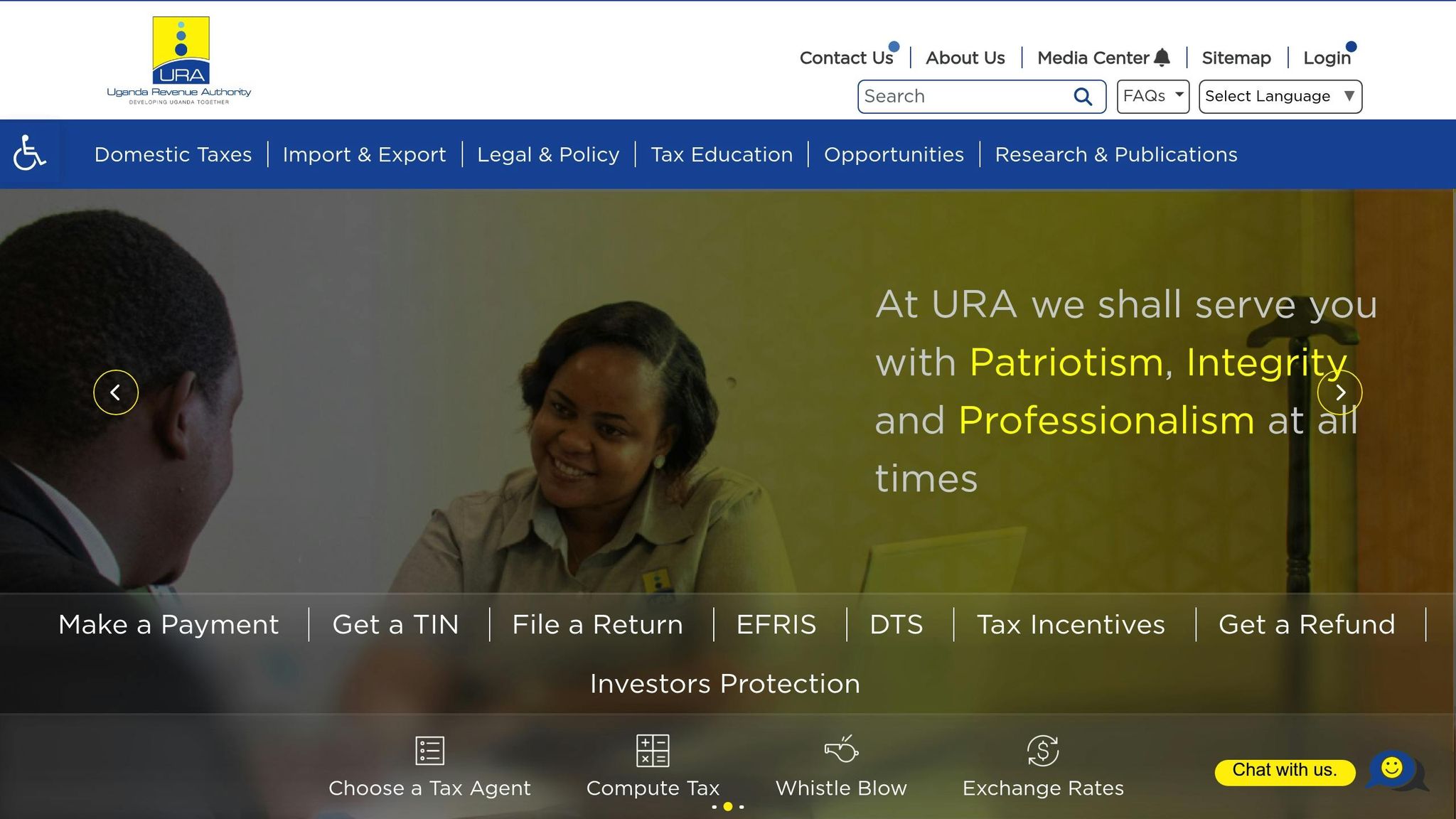Registering a used car in Uganda involves a few key steps to ensure compliance with safety and legal regulations. Here’s what you need to know:
- Inspection: Your car must pass a roadworthiness inspection based on Uganda’s safety standards (US845).
- Taxes and Fees: Pay import taxes, excise taxes, VAT, and registration fees through the Uganda Revenue Authority (URA).
- Required Documents: Gather essential paperwork like the vehicle logbook, bill of lading, standards certificate, Tax ID (TIN), and proof of identity.
- Registration: Complete the registration process online or in person with the URA.
- Number Plates: Collect your plates after registration is approved.
Prepare all documents in advance and consider hiring a clearing agent to avoid delays. Vehicles must be less than 15 years old and registered before leaving bonded warehouses. For detailed steps, refer to the article.
How to Import a Car to Uganda
1. Required Documents Checklist
Having the right documents is key to completing the car registration process in Uganda without any hiccups. The Uganda Revenue Authority (URA) requires specific paperwork to confirm vehicle ownership and ensure all regulations are met.
Vehicle Logbook
The vehicle logbook proves ownership and should include:
- Details of the previous owner
- Vehicle specifications like make, model, and year
- Engine and chassis numbers
- Registration history
- Records of any previous ownership transfers
For imported vehicles, make sure the logbook is authenticated by the relevant authorities in the country of origin or accompanied by a certified translation.
Bill of Lading
This document confirms the legal importation of the vehicle into Uganda. It should outline:
- Full vehicle details
- Port of origin
- Shipping dates
- Consignee information
- Container details
Vehicle Standards Certificate
To comply with the US845 pre-import inspection standard, you’ll need a vehicle standards certificate. This package generally includes:
- A Pre-Export Verification of Conformity (PVoC) certificate
- A one-year valid certificate of conformity
- A recent roadworthiness inspection report
Tax ID Number (TIN)
You can apply for a Tax ID (TIN) online through the URA website under the "Get a TIN" section. Submit the necessary documents and expect confirmation within 1-2 business days.
Identity Documents
For Ugandan citizens, the following are required:
- National ID or passport
- Proof of residence (e.g., utility bill or bank statement)
- Two recent passport-size photos
For non-citizens, the requirements include:
- A valid passport
- A work permit or residence permit
- An introduction letter from an employer or sponsor
- Two recent passport-size photos
Ensure all documents are either originals or certified copies. The URA may ask for additional paperwork depending on your situation or the type of vehicle. It’s a good idea to keep digital copies of everything for your records and future use. Once you’ve gathered these documents, you’re ready to move on to the vehicle inspection process for the next registration steps.
2. Vehicle Inspection Process
The vehicle inspection process is an essential step when registering a used car in Uganda. It ensures your vehicle complies with Ugandan safety and performance standards.
What Gets Inspected
Certified inspectors evaluate several critical components of your vehicle, including:
- Safety Systems: Brakes, airbags, seat belts, and emergency lights.
- Mechanical Components: Engine performance, emissions, transmission, suspension, and steering.
- External Features: Body condition, lighting systems, windows, windshields, and tires.
These checks help confirm your vehicle is roadworthy and safe.
Inspection Costs
Inspection fees depend on the type of vehicle and the inspection center. Generally, the process takes 2 to 4 hours.
Tips for a Smooth Inspection
- Schedule Ahead: Book an appointment at an authorized center at least a week before your registration date. This gives you time to handle any repairs if needed.
- Prepare Your Vehicle: Clean your car, ensure all parts are accessible, and have your documents ready.
- Post-Inspection: If your vehicle passes, you’ll receive a certificate of conformity. Keep this certificate – it’s required for registration with the Uganda Revenue Authority (URA).
The Uganda Bureau of Statistics (UNBS) introduced these standardized procedures to ensure consistency for all used vehicles entering the country. Keep your inspection records safe for future steps in the registration process.
3. Tax and Fee Payments
The URA handles tax and fee payments for vehicle registration through a secure online portal.
Import and Excise Taxes
These taxes are based on your vehicle’s value, as determined by URA’s guidelines. For the latest methods and rates, visit the URA website.
Value Added Tax (VAT)
VAT is calculated on the total of your vehicle’s value plus import and excise taxes. Payments must be made online. Be sure to save all receipts, as you’ll need them for the next steps in the registration process.
Registration Fees
The registration fee depends on your vehicle’s type and weight. To find the current fee schedule, check the URA website.
Once these payments are complete, follow the URA’s registration process to finalize your vehicle’s entry.
sbb-itb-7bab64a
4. URA Registration Steps

Once you’ve taken care of the taxes and fees, the next step is registering your vehicle with the URA. You can do this either online or in person.
Online Registration
Log in to the URA portal using your TIN and follow the step-by-step instructions provided to complete the registration process.
In-Person Registration
Prefer to handle it in person? Head to your nearest URA office with your TIN and all necessary documents. A URA officer will guide you through the process.
Once your registration is processed, follow the URA’s instructions to pick up your vehicle logbook.
5. Number Plate Collection
Once you’ve registered with the URA, the next step is to pick up your number plates. This process usually takes a few business days.
Regular Plates
Regular plates have a standard alphanumeric format. To collect them:
- Head to the specified URA office with your registration approval and payment receipt.
- Bring your ID and vehicle documents for verification.
- Complete any necessary paperwork and collect your plates.
- Securely install the plates using proper brackets and screws.
If you prefer a more personalized touch, you can choose custom plates instead.
Custom Plates
Custom plates let you create a unique plate number, as long as it adheres to URA rules. Here’s how to get them:
- Submit your application online through the URA portal or at the designated office.
- Wait for confirmation that your desired plate combination is available.
- Once confirmed, make the payment and pick up your plates.
Keep in mind that custom plate requests must align with URA regulations. Applications with inappropriate or restricted combinations will be denied.
This step wraps up the vehicle registration process.
Common Registration Problems and Solutions
Tips to Avoid Extra Fees
To avoid unnecessary charges during the registration process, make sure to:
- Check for any unpaid taxes through the URA online portal.
- Complete your vehicle inspection before starting the registration process.
- Gather all required documents in advance to prevent delays.
- Take advantage of URA’s online services to save both time and money.
- Fix any inspection-related issues promptly to comply with US845 requirements.
- Keep digital copies of all your submissions and receipts for easy reference.
These steps can help make your registration process smoother and reduce the chances of unexpected expenses. Stay updated by visiting the URA website regularly for the latest fee changes or requirements.
Vehicle Registration Requirements in Uganda
The Uganda Revenue Authority (URA) and Uganda National Bureau of Standards (UNBS) have specific guidelines for vehicle registration. Here’s a quick overview of what you need to know:
- Vehicles must be less than 15 years old from the date of first registration.
- Both Right-Hand Drive (RHD) and Left-Hand Drive (LHD) vehicles are allowed.
- Registration must be completed before the vehicle leaves the bonded warehouse.
To make the process smoother, consider working with a trusted clearing agent. They can assist with documentation, customs clearance, and other necessary paperwork.
For the most up-to-date requirements and fees, check the URA website. Ensuring all documents are complete and accurate will make the registration process much easier for your used car in Uganda.
Related posts
- How to Import a Car to Uganda: Complete Guide 2025
- Used Car Inspection: 10-Point Checklist Before Buying
- How To Transfer Car Ownership In Uganda
- Where to buy used cars in Kampala




